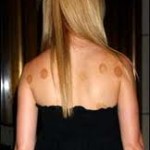Billy Bush and Kit Hoover Get Cupped

Remember cupping?
You know, that Traditional Chinese Medicine treatment that’s left those funny round marks on the backs of Gwyneth Paltrow, Paris Hilton, Victoria Beckham and Jessica Simpson?
On yesterday’s Access Hollywood Live, co-hosts Billy Bush and Kit Hoover were given a cupping treatment live on set.
Here’s the video:
Although they seemed to be enjoying the session, will it have any effect on their health?
Traditional Chinese medicine (TCM)
Traditional Chinese medicine originated in ancient China and has evolved over thousands of years. TCM practitioners use herbs, acupuncture, and other methods to treat a wide range of conditions. In the United States, TCM is considered part of complementary and alternative medicine (CAM).
Traditional Chinese medicine, which encompasses many different practices, is rooted in the ancient philosophy of Taoism and dates back more than 5,000 years. Today, TCM is practiced side by side with Western medicine in many of China’s hospitals and clinics.
Underlying Concepts
Underlying the practice of TCM is a unique view of the world and the human body that is different from Western medicine concepts. This view is based on the ancient Chinese perception of humans as microcosms of the larger, surrounding universe—interconnected with nature and subject to its forces. The human body is regarded as an organic entity in which the various organs, tissues, and other parts have distinct functions but are all interdependent. In this view, health and disease relate to balance of the functions.
The theoretical framework of TCM has a number of key components:
- Yin-yang theory—the concept of two opposing, yet complementary, forces that shape the world and all life—is central to TCM.
- In the TCM view, a vital energy or life force called qi circulates in the body through a system of pathways called meridians. Health is an ongoing process of maintaining balance and harmony in the circulation of qi.
- The TCM approach uses eight principles to analyze symptoms and categorize conditions: cold/heat, interior/exterior, excess/deficiency, and yin/yang (the chief principles). TCM also uses the theory of five elements—fire, earth, metal, water, and wood—to explain how the body works; these elements correspond to particular organs and tissues in the body.
These concepts are documented in the Huang Di Nei Jing (Inner Canon of the Yellow Emperor), the classic Chinese medicine text.
Cupping
Cupping is one of the oldest methods of traditional Chinese medicine. In cupping, local suction is created on the skin; practitioners believe this mobilizes blood flow and removes toxins which promotes healing.
Broadly speaking there are two types of cupping: dry cupping and bleeding or wet cupping.
 In both methods, an area of low pressure is created next to the skin by the cup. This draws the skin into the cup, lifting the muscle fascia and pulling it away from the underlying sub-fascia. It also increases blood flow to the underlying area.
In both methods, an area of low pressure is created next to the skin by the cup. This draws the skin into the cup, lifting the muscle fascia and pulling it away from the underlying sub-fascia. It also increases blood flow to the underlying area.
The cups can be various shapes including balls or bells. Plastic and glass are the most common materials used today, replacing the horn, pottery, bronze and bamboo cups used in earlier times.
In dry cupping, the low air pressure can be created by heating the cup or the air inside it with an open flame (called fire cupping) or a bath in hot scented oils, then placing it against the skin. As the air inside the cup cools, it contracts and draws the skin slightly inside. Alternately, a vacuum can be created with a mechanical suction pump acting through a valve located at the top of the cup. The cups can be left in place, or moved around th e affected area.
e affected area.
In wet cupping, a small scratch or incision is made with a lancet before the cup is applied. The pressure difference extracts blood from the skin.
Patients report that cupping feels a bit like a deep tissue massage. Skin marking is common after the cups are removed. This may be a simple red ring that disappears quickly, or swelling and bruising may persist for a few days.
Does it work?
Unlike many other health fads, cupping has been subjected to a considerable amount of scientific investigation. Studies have looked at it’s use in a wide variety of ailments, including low back pain, herpes zoster (shingles), cancer pain, and migraine headaches.
 Although many studies have been done, many are considered to be of “low methodological quality” by scientists who have reviewed them, leaving their results suspect. However, the same reviewers state that “cupping has potential effect in the treatment of herpes zoster and other specific conditions” but that more rigorously designed trials are necessary.
Although many studies have been done, many are considered to be of “low methodological quality” by scientists who have reviewed them, leaving their results suspect. However, the same reviewers state that “cupping has potential effect in the treatment of herpes zoster and other specific conditions” but that more rigorously designed trials are necessary.
Fortunately, the studies have also revealed that cupping has no serious side effects (although some skin burns have been described.)
As Professor Edzard Ernst, an international authority on complementary medicine at the University of Exeter, says:
There is no evidence for its efficacy. It has not been submitted to clinical trials, but there have certainly been satisfied customers for 3,000 years.
Have any of you tried cupping? What was your experience like? Did it help you?
For more information, go to the Resounding Health Casebook on Cupping.



























0 comments